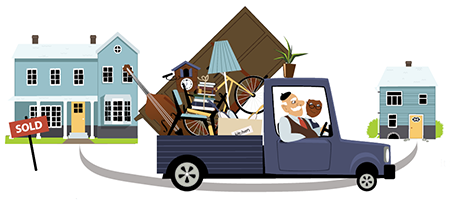Downsizing sounds like a great idea… until you begin to wrap your head around the massive task of moving. The thought of leaving a longtime home, with all of its associations — the height chart on the laundry room doorframe, the grave of a beloved pet — can be heart-wrenching. Add to that the cost of moving and the burden of offloading half (or more) of your possessions, and the project can quickly overwhelm even the most capable older adult.
The best way to tackle downsizing, according to the experts, is by breaking the process down into smaller, more manageable bits that you can accomplish in a matter of hours or days. Professional organizer Susan Santoro recommends taking photos of your home before you dig into decluttering.
“These photos will help you if you have any moments of regret over items you’ve let go,” says Susan. “You should also take photos of each item that is special to you that you will be letting go.”
Then, start with drawers that hold unsentimental items, such as leftover electronics, and go from there. Set a time limit and a goal for the number of spaces to go through each day.
Divide Into Piles
There are many ways to tackle cleaning out your home, from the KonMari (https://konmari.com) method of keeping only that which sparks joy, to Project 333 (https://bemorewithless.com/project-333) which advocates keeping only 33 pieces of clothing and accessories. One trick that works for most people is to completely empty the drawer, closet, box or whatever space you’re working on and divide items into three piles.
The keep pile is for items you are sure you want to hold on to.
The donate pile is for things that have useful life left, but that you don’t need anymore.
The trash pile is for possessions that, upon reflection, no one will find value in. You can make a separate pile for trash items with sensitive information that need to go through a shredder before getting discarded.
Don’t make the mistake of keeping numerous items for children or grandchildren without asking them.
“Talk with children and family to determine what items they would like to keep and what they are not interested in,” suggests Susan. “This information will make it easier for you to make decisions.”
Because younger generations are more interested in experiences than stuff, “understand that your children may want very few items, regardless of how special those items are to you,” says Susan. Sadly, it’s unlikely anyone wants your china. Instead, check out ideas online (search for “family china nobody wants”).
Do not criticize their choices or try to shove extra items their way. Instead, think of the joy your “unwanted” items will give someone who runs across them on eBay or in a thrift shop. If you think you have a friend who would love to get your unclaimed juicer, make sure that they don’t feel obligated to accept your gift.
That being said, offer to keep items available only until a certain date. If someone really wants it, they’ll find a way. Mark the offer on your calendar and toss or donate the items that have not been picked up by the “expiration date.”
Paperwork
Photos can be kept as is or filed electronically. If the task seems mind boggling, hire someone to digitize them for you. Go through them first and keep only the best of those with recognizable people and places.
You only need to keep the last seven years of tax returns. Prior iterations should be shredded and used as packing material or recycled. Check with your attorney or accountant regarding other documents. Business documents and agreements belong in a safe or safe deposit box, with digital copies on your computer.
Furniture
Measure your new space and make sure your existing furniture will fit. You’d be surprised how many people fail to do this and find themselves with a moving van full of unworkable couches and tables! Instead find a furniture layout app (https://niblockhomes.com/top-5-furniture-layout-apps) to use. If you still have the big, bulky pieces popular a decade or two ago, consider donating them and getting sleek new pieces for your new place.
We all tend to hang on to things that are imbued with sentimental value. If a spouse has passed away, most of us will want to keep the old bed and their favorite chair. We look at the dining room set and think of all the meals served there as the kids grew up.
Downsizing is a good time to take a photo of these relics for memory’s sake and switch to items that will be a better fit in your new life. It’s not disrespectful, it’s simply moving on to the next phase of life that will be here whether you spend it sleeping in a king-size bed or a double.
Sell It
You may be able to sell unwanted items, but make sure not to become so involved in making a small amount of money that your move is delayed. Some people hold a garage sale and make everything free on the last day. You can advertise multiple items on Craigslist and then make them all available on one day, at one time to save yourself a lot of hassle. You can even choose to use eBay or Facebook Marketplace, but be aware it can be a time-intensive process unless you are willing to take offers. Perhaps you have a family member who will post items for you in exchange for a cut of the profits. If you have very valuable items, you can contact an estate liquidator or even a museum.
Get rid of bulk items. You do not need to bring a huge pack of batteries or toilet paper from Costco. Tell your inner frugal-Meister to take a deep breath and learn to walk past the bulk sales aisle, as much as it may hurt at first.
Hire Help
Downsizing can take months or years in some homes. Start as early as you can, but know that sometimes getting help with the task is the smartest way to go. The National Association of Productivity & Organizing Professionals (www.napo.net) is a good place to find someone who organizes for a living and will be able to help with everything from your emotional well-being to how to post that paisley chair on Craigslist.
A professional organizer can be used just to get you started or as a stalwart partner for the whole process. These are not cleaners; they are not there to do your windows. Organizing pros can help you make those tough decisions, whisk away items that are bound for the dump and tell you funny stories about other clients they’ve had to keep your spirits up while you both work. They can also search a book collection for old stock certificates that may have been hidden between pages (true story!) and they’ll know where to get grandpa’s stamp collection valued.
Whether you’re planning a move or not, there is no time like today to pare down your possessions. Consider it a gift to your heirs, who will otherwise have to go through everything themselves eventually.
You may find that you begin to feel a weight come off your shoulders as possessions leave and your home becomes more spacious and airy. You may even begin to think of new projects you’d like to tackle as you master downsizing!
SCSA (Society of Certified Senior Advisors)
The SCSA educates and supports specialists in aging dedicated to improving lives of older adults.
1-800-653-1875 | www.csa.us



Leave a Reply